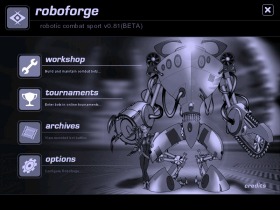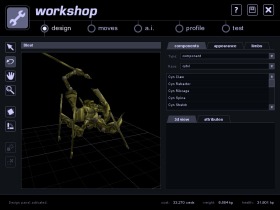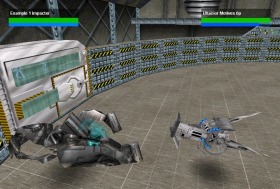 Home
News, and the latest updates.
Archives
Stories from the past...
Submit News
Got a item of interest? Here's the place to go.
Feedback
Your opinion always counts on how we can make GameSurge
even better.
Mailbag
Comments on our features, by you, the viewers. | 
Hardware
Tweaks, reviews and a handy driver index highlight our newest section
Reviews
Looking to buy one of the hottest games? We have it covered.
Previews
Get a advanced look at the games of tomorrow.
Interviews
Find out more about the people behind your favorite game.
Strategy
Need Help? We have a very large selection of walkthroughs now up.
Gallery
A special section featuring the best in artwork and
images. |

Editorials
The written word, by staff and viewers.
Game Guy
A bi-monthly column contributed by Mark H Walker, an independant writer in the Gaming community.
Gallery
Pictures from around the web.
Hosting
Our current hosting plans and features.
Site Information
Who we are, what we do, our policies and job positions.
|


PlayStation
The Sony PlayStation, and beyond...
Nintendo 64
Currently Down.
Dreamcast
The Dreamcast resource, and more. Home of the DC Technical pages. |
|
Roboforge - a thinking man's beat-em-up?
previewed by Dorphen
edited by Falcon
Strategic Beat-em-up.
If you are around 25 or older, you may remember an old 2D robot battle
game called 'Arena' or 'Robots', where the bots were represented by simple
circles. These robots had two forms of weapons - a short range laser
and a ranged cannon - and a simple on/off shield. The object of the
game was to write a small program representing the brain of the robot and
place the bot into the arena for combat. The bots in the battle would
then run their programs until one or the other was destroyed, or you got
fed up waiting and interrupted the fight. Roboforge has brought this
idea firmly into the twenty-first century.
So, what is Roboforge? Well, Roboforge
is a kind of strategic beat-em-up style game that is probably quite different
to anything you have played before. It is strategic in the sense
you need to think a bit in order to succeed and it is a beat-em-up because
you're designing gigantic robotic gladiators to enter into an arena to
go one-on-one against an opponent. You do not control the robot in the
actual fights - your pre-programmed AI and the game engine calculations
will do all the fighting and you can watch the completed battle once it
has finished. Battles can be saved once completed, and are surprisingly
small, depending on the complexity of the battle 120-180 second fights
are roughly 1MB.
 Technical Trivia Technical Trivia
The game is written in Java and uses the Java 3D(tm) API. It runs using either
DirectX or OpenGL. You will have to load the proper version of Java 3D depending
on your graphics card. As with most 3D games, the faster your processor,
and the more memory you have, the better. Roboforge is quite memory
intensive. 64MB is about the minimum you need in order to get pleasure
from the game rather than frustration caused by a thrashing disk, but 128MB+
makes the whole experience much more enjoyable.
At the heart of the game is a physics simulation engine which handles
the calculations for damage dished out by collisions between weapons, shields,
and other components. Simply speaking, speed is the key to success...the
faster the weapon is moving when it strikes your opponent, the more damage
you do. Obviously though, in actuality, things are a wee bit more
complicated.
You can generate battles on your own, or fight online against other
Roboforgers. |
Building Basic Bots
In order to enter into combat against an opponent, you must first construct
your robot gladiator. There are two ways to do this. 1 - via a bot
construction wizard, or 2 - through entirely manual construction.
Bots created in either way are exactly the same so the wizard is definitely
the way to go while you are learning the game. The end result will be a
bot with a range of abilities and characteristics including flying, rolling
or walking robots shaped from anything from a helicopter to a humaniod
to nothing you've ever seen before.
 Wise Wizards Wise Wizards
Using the bot construction wizard, you can get a robot up and running
quite quickly. The wizard first gets you to select a base chassis
for the bot. Next, you step through a series of selections where
you get to choose between two possibilities (generally of different cost)
for items such as controller (CPU), energy source, sensors and weapons.
This allows you to slightly tailor the physical characteristics of your
bot. After you've decided on the physical construction of the bot,
you must select elements of A.I. (Artificial Intelligence - of which more
later...). The A.I. options allow you to give the bot behavioral
characteristics such as whether it will move straight in front of the opponent,
or dodge and weave around it. The final step in the wizard construction
process is to name your bot, and after that you end up with a fully functional
robot which you can use to battle against others (assuming you selected
A.I. options rather than choosing 'none'). |
Manual Manufacturing
The second construction method involves you building up your bot, component
by component starting with a completely bare chassis. You get to
explicitly choose each component (from a library of well over 200) for
your bot. These components are added by a simple 3D drag and drop
interface. Each component has a number of connect points which can
be used to connect it (surprisingly enough) to other components or the
chassis. You also have the option of selecting different textures
and colour schemes for each individual component.
Moves of Mayhem
Once you have constructed your bot, with a controller, an energy source,
sensors, shields and weapons, you are ready to make it move. There
are two types of movement: Chassis moves, which move your entire robot,
and plain Moves which you can use to move parts of your bot around, but more importantly,
you use to make your robot carry out attack strikes.
You choreograph the robot's moves within the Move panel of the workshop.
This is done by means of snapshots, which is just like key-framing in animation.
You take a snapshot of a key position which you require the joints (and
thus weapon) to be and the game works out what action must occur in order
to produce the desired configuration.
 Zany Zones Zany Zones
The addition of Zones also takes places from within the Moves panel.
You use zones to gain more detailed information about your surroundings,
in particular, information regarding the presence of some part of the opponent
within a particular cubic volume of space. The zones are volumes
of interest, which, as long as they lie within the field of view of a sensor,
can provide you with information like whether or not the enemy's controller
lies inside.
|
Onto page 2:
|
 |
|
|
Zalman: ZM-DS4F Headphones
|
An affordable, ultra-portable headphone set.
 more more
|
|
